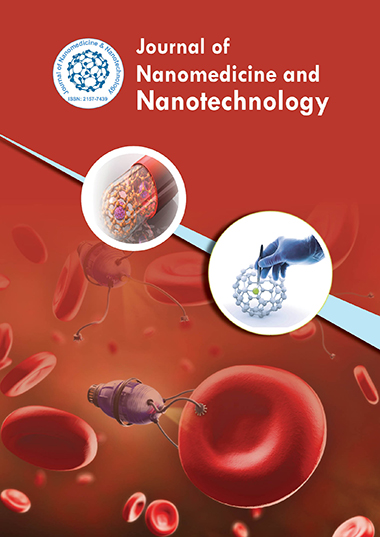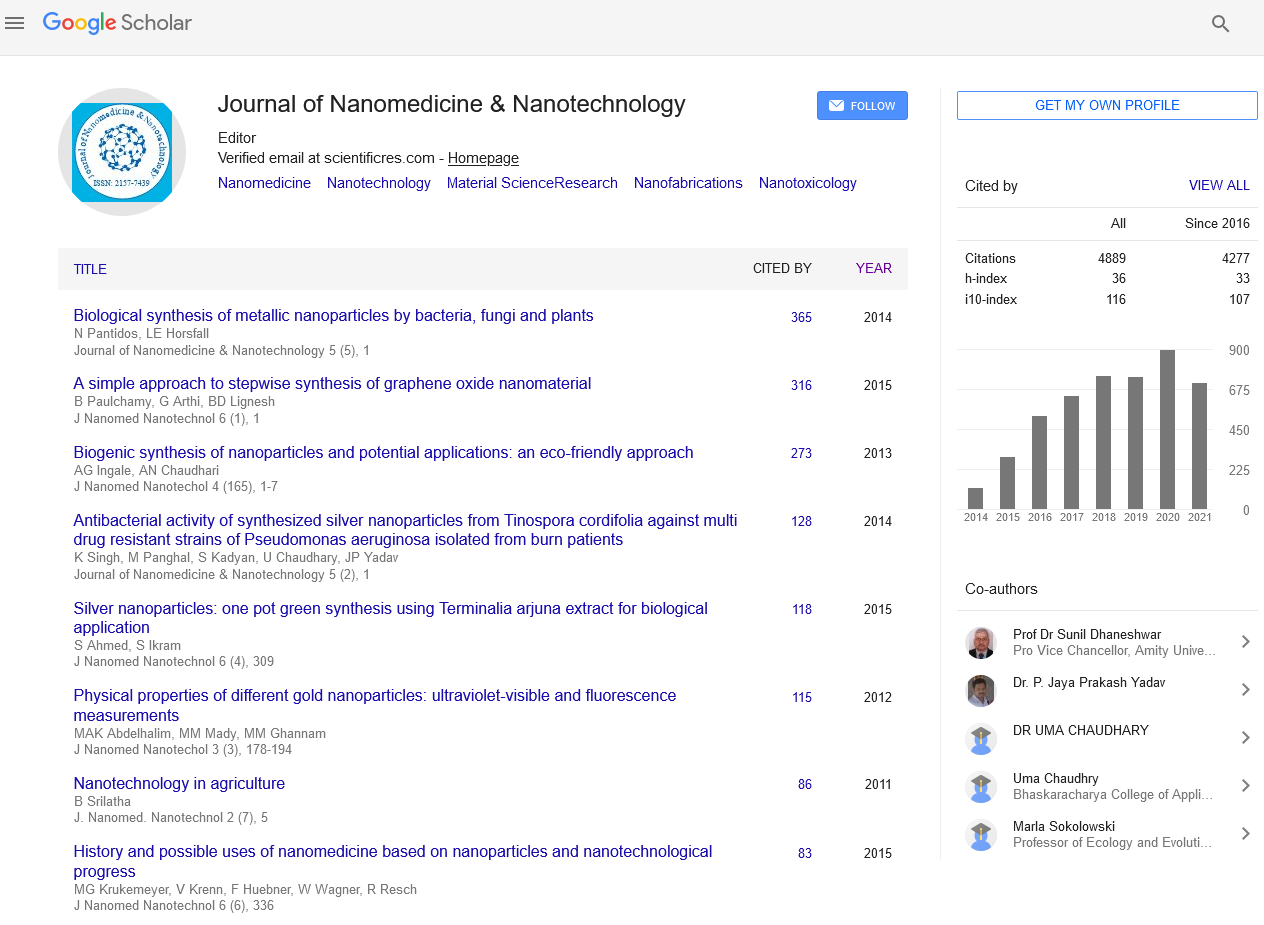Indexed In
- Open J Gate
- Genamics JournalSeek
- Academic Keys
- JournalTOCs
- ResearchBible
- China National Knowledge Infrastructure (CNKI)
- Scimago
- Ulrich's Periodicals Directory
- Electronic Journals Library
- RefSeek
- Hamdard University
- EBSCO A-Z
- OCLC- WorldCat
- SWB online catalog
- Virtual Library of Biology (vifabio)
- Publons
- MIAR
- Scientific Indexing Services (SIS)
- Euro Pub
- Google Scholar
Useful Links
Share This Page
Journal Flyer

Open Access Journals
- Agri and Aquaculture
- Biochemistry
- Bioinformatics & Systems Biology
- Business & Management
- Chemistry
- Clinical Sciences
- Engineering
- Food & Nutrition
- General Science
- Genetics & Molecular Biology
- Immunology & Microbiology
- Medical Sciences
- Neuroscience & Psychology
- Nursing & Health Care
- Pharmaceutical Sciences
Editorial - (2024) Volume 15, Issue 6
Nanostructured Catalysts for CO2 Reduction and Conversion into Value-Added Chemicals
Magnolia O Hara*Received: 02-Nov-2024, Manuscript No. jnmnt-24-28299; Editor assigned: 05-Nov-2024, Pre QC No. jnmnt-24-28299 (PQ); Reviewed: 20-Nov-2024, QC No. jnmnt-24-28299; Revised: 25-Nov-2024, Manuscript No. jnmnt-24-28299 (R); Published: 30-Nov-2024, DOI: 10.35248/2157-7439.24.15.762
Abstract
The reduction and conversion of carbon dioxide (CO2) into value-added chemicals presents a promising solution for mitigating climate change while producing valuable products. This process, known as CO2 utilization or carbon capture and conversion (CCC), has garnered significant attention due to its potential to close the carbon cycle and provide sustainable feedstocks for the chemical industry. Nanostructured catalysts play a pivotal role in enhancing the efficiency and selectivity of CO2 reduction reactions (CO2RR) by providing a high surface area, tunable catalytic sites, and unique electronic properties. Recent advances in nanomaterials, including metal nanoparticles, carbon-based nanomaterials, and transition metal dichalcogenides, have demonstrated promising catalytic performance for CO2 reduction to a wide range of products, including methanol, formic acid, carbon monoxide, and hydrocarbons. This article reviews the latest developments in nanostructured catalysts for CO2 reduction, discussing their synthesis, reaction mechanisms, and challenges in terms of efficiency, stability, and scalability. Additionally, the article highlights the future prospects of these catalysts for large-scale CO2 conversion processes, focusing on the integration of renewable energy sources and the development of advanced catalytic systems for sustainable chemical production.
Keywords
CO2 reduction; Nanostructured catalysts; Carbon capture; Value-added chemicals; Electrochemical reduction;
Catalytic mechanisms; Sustainable chemistry
INTRODUCTION
The increasing concentration of carbon dioxide (CO2) in the atmosphere due to human activities has led to climate change, prompting efforts to develop technologies that can capture and utilize CO2 as a resource rather than a waste product. One of the most promising approaches is CO2 reduction, where CO2 is converted into value-added chemicals such as hydrocarbons, alcohols, and other organic compounds. This process not only mitigates the environmental impact of CO2 emissions but also provides valuable feedstocks for industries such as chemicals, fuels, and materials [1]. Nanostructured catalysts have emerged as a key technology for enhancing the efficiency and selectivity of CO2 reduction reactions (CO2RR). Their high surface area, tunable electronic properties, and ability to facilitate unique reaction pathways make them highly effective for catalyzing CO2 conversion at low overpotentials. Recent research has focused on the development of novel nanomaterials and catalytic strategies to improve the performance of CO2RR, particularly in terms of activity, selectivity, and long-term stability. This review highlights the latest advances in nanostructured catalysts for CO2 reduction and their potential for large-scale applications in CO2 utilization [2].
TYPES OF NANOSTRUCTURED CATALYSTS FOR CO2 REDUCTION
Several types of nanostructured catalysts have been investigated for CO2 reduction, each offering distinct advantages in terms of catalytic efficiency and product selectivity. These include metal-based catalysts, carbon-based materials, and transition metal dichalcogenides (TMDs) [3].
Metal Nanoparticles
Metal-based catalysts, particularly those composed of copper (Cu), silver (Ag), gold (Au), and palladium (Pd), have shown significant potential for CO2 reduction reactions. Among these, copper is particularly noteworthy due to its ability to catalyze the reduction of CO2 to a variety of products, including methanol, ethanol, and hydrocarbons. Copper nanoparticles (CuNPs) exhibit unique electronic properties that enable the formation of a broad spectrum of products with high selectivity. The particle size, shape, and surface structure of CuNPs can be tailored to optimize their catalytic performance for specific CO2RR pathways [4].
Carbon-based Nanomaterials
Carbon-based nanomaterials, such as graphene, carbon nanotubes (CNTs), and graphene oxide, have been explored as alternative catalysts for CO2 reduction due to their excellent conductivity, high surface area, and ability to support metal loading. Graphene-based catalysts have shown promise in the electrochemical reduction of CO2 to formic acid and carbon monoxide. Additionally, carbon-based materials can serve as supports for metal nanoparticles, thereby enhancing the overall catalytic activity and stability of the system [5].
Transition Metal Dichalcogenides (TMDs)
Two-dimensional transition metal dichalcogenides (TMDs), such as MoSâ??, WSâ??, and MoSeâ??, have recently emerged as promising catalysts for CO2 reduction. These materials exhibit high catalytic activity for the electrochemical conversion of CO2 to CO, methane, and other products. The unique properties of TMDs, such as their high surface-to-volume ratio and the presence of active sites on their edges, make them ideal candidates for CO2RR. Additionally, TMDs can be easily functionalized with metal atoms or nanoparticles to further enhance their catalytic performance.
Reaction Mechanisms in CO2 Reduction
The CO2 reduction reaction (CO2RR) is a complex electrochemical process that involves multiple steps, including the adsorption of CO2 onto the catalyst surface, electron transfer, and the formation of intermediate species that are subsequently reduced to desired products. The reaction pathway and selectivity for specific products depend on various factors, including the catalyst material, the applied potential, and the reaction conditions [6].
CO2 Adsorption
The first step in CO2RR is the adsorption of CO2 onto the catalyst surface. The efficiency of CO2 adsorption is influenced by the surface energy and electronic properties of the catalyst. Metal nanoparticles, for instance, possess surface plasmon resonances that can enhance CO2 adsorption, while carbon-based materials provide a favorable environment for CO2 chemisorption [7].
Electron Transfer and Intermediate Formation
Following CO2 adsorption, the catalyst facilitates electron transfer to CO2, leading to the formation of reactive intermediates such as COâ??•− (carbon dioxide anion) or CO (carbon monoxide). These intermediates play a crucial role in determining the reaction pathway and product distribution. The specific binding sites on the catalyst surface and the availability of charge carriers are key factors that govern the electron transfer process.
Product Formation
The final step in CO2RR involves the reduction of intermediates to produce value-added chemicals. Metal-based catalysts, particularly copper, have been shown to facilitate the formation of a variety of products, including hydrocarbons, alcohols, and aldehydes. On the other hand, carbon-based and TMD catalysts are more selective for the production of small molecules such as formic acid and carbon monoxide [8]. The reaction pathway is influenced by factors such as the applied potential, reaction temperature, and the presence of co-catalysts.
CHALLENGES AND LIMITATIONS
Despite the promising potential of nanostructured catalysts for CO2 reduction, several challenges remain in optimizing their performance for large-scale applications
Catalytic Efficiency and Selectivity: The efficiency and selectivity of CO2 reduction catalysts are often limited by factors such as poor electron transfer, catalyst degradation, and the formation of unwanted side products. Achieving high selectivity for specific products, such as hydrocarbons or alcohols, remains a major challenge.
Stability and Durability: The long-term stability of nanostructured catalysts is a critical factor for their practical application. Many catalysts suffer from deactivation over time due to factors such as corrosion, aggregation, or sintering. Developing catalysts with enhanced stability under realistic reaction conditions is essential for their commercialization.
Scalability: While laboratory-scale experiments have demonstrated the potential of nanostructured catalysts for CO2 reduction, scaling up the process to industrial levels poses significant challenges. The synthesis of large quantities of high-quality catalysts, along with the integration of these materials into functional systems, is a key barrier to the widespread adoption of CO2 reduction technologies [9].
FUTURE DIRECTIONS
The future of CO2 reduction and conversion into value-added chemicals lies in the development of novel catalytic materials and reaction systems that can overcome current challenges. Hybrid catalysts, combining metals with carbon-based materials or TMDs, have shown great promise in improving catalytic performance. Additionally, advancements in reaction engineering and electrochemical cell design are expected to enhance the overall efficiency of CO2 reduction processes. The integration of renewable energy sources, such as solar or wind power, into CO2 reduction systems will also play a critical role in making these technologies sustainable and commercially viable. Moreover, artificial intelligence (AI) and machine learning are increasingly being used to design and optimize catalysts, accelerating the discovery of new materials and reaction pathways. These technologies will be pivotal in addressing the scalability and cost challenges associated with CO2 reduction [10].
CONCLUSION
Nanostructured catalysts offer tremendous potential for the reduction and conversion of CO2 into value-added chemicals, providing a sustainable approach to mitigate climate change and produce useful chemical products. While significant progress has been made in the development of these catalysts, challenges related to efficiency, selectivity, stability, and scalability remain. Continued research into novel nanomaterials, reaction mechanisms, and reactor designs will be essential to overcoming these challenges and realizing the full potential of CO2 reduction technologies for large-scale, sustainable chemical production.
REFERENCES
- Fulekar M. Nanotechnology: importance and applications. IK International Pvt Ltd. 2010.
- KaradeV, Waifalkar P, Dongle T, Sahoo S C, Kollu P, Patil P et al. Greener synthesis of magnetite nanoparticles using green tea extract and their magnetic properties. Mater Res Express.2017; 4(9): 096102.
- Alfredo V, IsaÃas J, Hernandez E, Perez S, Angelica L, Landeros Sanchez B. Synthesis and characterization of magnetite nanoparticles for photocatalysis of nitrobenzene. J Saudi Chem Soc.2020; 24(2): 223-235.
- Avasthi A, Caro C, Pozo-Torres E, Leal M P, GarcÃaâ??MartÃn M L. Magnetic Nanoparticles as MRI Contrast Agents. Topics in current chemistry.2020; 378(3): 40.
- Liu S, Yu B, Wang S, Shen Y, Cong H. Preparation, surface functionalization and application of Fe3O4 magnetic nanoparticles. Adv. Colloid Interface Sci.2020; 102165.
- Almomani F, Bhosale R, Khraisheh M, Almomani T. Heavy metal ions removal from industrial wastewater using magnetic nanoparticles (MNP). Appl Surf Sci.2020; 506: 144924.
- Zulfiqar N. Effect of adding surfactant additives (sodium lauryl sulphate) in water on the performance of flat plate solar distillation system for the purification of water. 2023.
- Poole C P, Owens F J. Introduction to nanotechnology. 2003.Â
- Mirza S, Ahmad M S, Shah A, Ateeq M. Magnetic nanoparticles: drug delivery and bioimaging applications. 2020; 189-213.
- Iravani S, Korbekandi H, Mirmohammadi S V, Zolfaghari B. Synthesis of silver nanoparticles: chemical, physical and biological methods. Int J Pharm Sci.2014; 9(6): 385.
Indexed at, Google Scholar, Crossref
Indexed at, Google Scholar, Crossref
Indexed at, Google Scholar, Crossref
Indexed at, Google Scholar, Crossref
Indexed at, Google Scholar, Crossref
Indexed at, Google Scholar, Crossref
Indexed at, Google Scholar, Crossref
Citation: Magnolia O (2024) Nanostructured Catalysts for CO2 Reduction and Conversion into Value-Added Chemicals. J Nanomed Nanotech. 15: 762
Copyright: ©2024 Magnolia O. This is an open-access article distributed under the terms of the Creative Commons Attribution License, which permits unrestricted use, distribution, and reproduction in any medium, provided the original author and source are credited.


